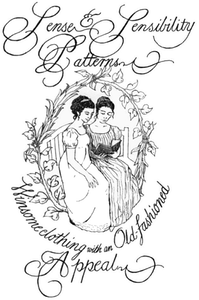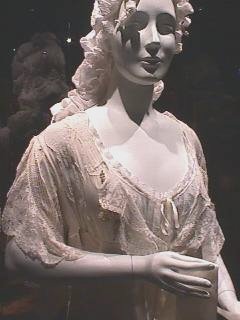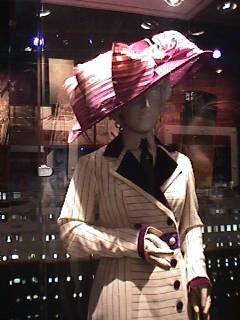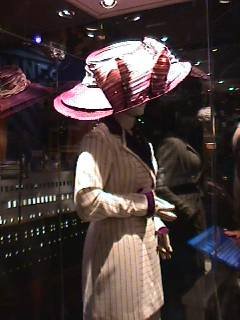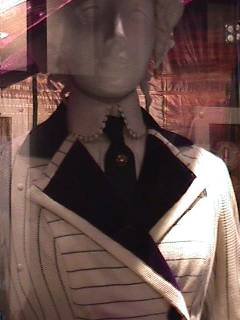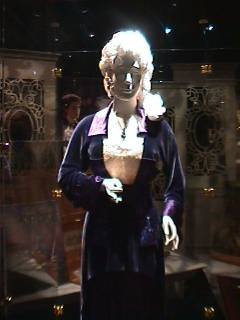Titanic on Tour Exhibit Photos
I had the opportunity to visit Paramount's "Titanic" costume exhibit right before it left King's Dominion near Richmond, Virginia, in 1999, and it was a treat! I took two disks full of photos with my digital camera, and I took another roll of photos with my film camera. You'll notice the difference in color between the digital camera and the conventional. The digital is truer to life. Also be sure to visit The Costume Gallery, run by Penny Ladnier. Penny has more digital photos from the exhibit. [2023 addendum: By today’s standards, these photos are a grainy mess. My digital camera at the time took a 3.5” floppy disk—go ahead and laugh! Thanks for stopping by anyway. Running a search on Pinterest will turn up lots of good, high quality shots of these costumes taken long after my camera went to its grave!]
Most of the costumes were in glass cases and beautifully displayed. (I just wish I could have gotten behind them!) The lighting in the exhibit was, unfortunately, right over the heads of the mannequins, which means some areas in the pictures are dark and difficult to make out. I took lots of detail shots of the gowns, which turned out pretty well in spite of the lighting. The photos of the "flying" dress, which is a dark royal blue, did not turn out as well as I would have liked, since a lot of details were lost in the shadows. There were also eight costumes placed behind painted scrims, which made them nearly impossible to photograph. With my nose up to the scrim, I could see what I wanted to of Rose's first-class dinner gown, but the camera could not get past the screen effect. I've included a couple of those shots anyway, to give you an idea of the different displays.Several of the gowns on display were obviously made from vintage pieces or fabrics, including Rose's dressing gown (gorgeous tucked silk with delicate Brussels lace), one of Ruth's coats (see the fabulous details in the closeups) and Mrs. J. Astor's first-class dinner gown (incredible embroidery on silk and lace). Rose's yellow and white strolling dress may have used vintage fabrics as well. The yellow tone-on-tone silk was exquisite. And the "flying" dress itself was patterned after an original suit dress owned by the wife of a prominent Pennsylvania politician. The original, sold to the film by a vintage clothier in Leesburg, Virginia, was black and white. The luscious deep blue velvet with satin accents and lace bodice inset made a gorgeous rendition. (See the bottom of the page for detailed notes on each costume I photographed.)
All in all, it is a fun exhibit for the costume and/or film buff. I spent a good hour drooling over the velvets, silks and satins, and I'm inspired to get to work, playing with some new draping techniques and trying out some more of my Titanic-era patterns!
Rose's boarding suit:
Photos from my regular film camera:
Rose's "flying"dress:
Photos from my regular camera:
Rose's dressing gown:
Photo from my regular camera:
Rose's strolling dress:
Photos from my regular camera:
Rose's "swimming" dress:
Photos from my regular camera:
Ruth's coat:
Cal's boarding suit:
Rose's dinner dress behind the scrim:
Dress worn by the countess and first class gent's tux behind scrim:
Mrs. Astor's dress behind scrim:
Photos from my regular camera:
Here are some photos that were taken by another costume enthusiast and recently sent to me. They give some more details of the dresses behind the scrim.
Pictured above: Mrs. Astor's dress (detail of bodice), the Countess of Rothes' dress (details of bodice and skirt), the dinner dress bodice, detail of dinner bodice, detail of dinner dress skirt, and Cora's doll.
Costume Notes
Rose's Boarding Suit: This is a wonderful outfit to view up close. The fabric is similar to a heavy twill with thin black stripes, and purple satin is used as the accent color. The stripes are employed to great effect on this suit. They run horizontally across the center front and center back portions of the jacket and again in the inset where the skirt is draped at the bottom. Purple satin is used to accent the collar, belt, buttons, and the inside of Rose's gloves. They are lined with purple satin and are divided at the inner wrist, creating a truly striking look. In the photos, the gloves have been turned back over the end of each sleeve, which makes them look like cuffs. Purple covered buttons are used on the double-breasted jacket and on the skirt, with the exception of the four buttons on the belt front and back. These are covered with the suit material. The hat, which takes center stage early in the film, is of a Parasisol Capeline with a double border of braided Milan Straw. (Thanks to Karen Cross for this info!) The entire costume is a visual delight. Colors and patterns work together to create a most striking image and one that's fun to view again and again. Which of us costume buffs didn't gasp when Rose stepped out of the car in that fabulous get-up?
Rose's "Flying" Dress: The costumer who sold the original gown to the film tells me that it belonged to the wife of the governor of Pennsylvania, who had exquisite taste in clothing. The original was black velvet with black satin accents and a white bodice inset with lace. Deborah Scott took that basic design and went even further with the use of a gorgeous royal blue velvet, purplish-blue satin accents and fabulous antique lace for the bodice inset. It has three-quarter length sleeves, and the cuffs are satin with neat button/tab details. You can see these three satin bands briefly in the film, but they are usually hidden by Rose's shawl. The best shot of them is right before the sketch scene. At any rate, the outfit is beautifully done with fantastic draping effects and machine embroidery on the lower lapels and skirt inset (my photo of this detail did not turn out, unfortunately). The overskirt which hangs down from the bodice has tassels on each side, seen in one of my detail shots above. The velvet itself is sumptuously rich and not at all stiff. It hangs wonderfully. I'd love to know where the materials for this outfit were purchased!
Rose's Dressing Gown: This must have been made from vintage materials. The fabric is wonderful antique silk with tiny tucks running up and down the length of the gown. The lace is wonderfully detailed and soft, hanging in beautiful folds. There is ribbon embroidery on the right side of the gown, but it is gone from the left side. (Note that Kate Winslet was shot only from the right side or from the neck up when she wore this piece.) The camisole underneath the dressing gown looks new. The lace is stiffer and whiter, where the dressing gown is a creamy faded white. Simply exquisite. I'd give my eyeteeth to find antique lace of this quality.
Rose's Strolling Dress: I'd love to find out if this is an original vintage piece or made for the film. If it was made, antique fabrics were used. The bodice is of a fine cream silk only seen on vintage gowns of that era. It has a wonderful embroidered design on the shoulders, wrists and around the front neckline in a brownish-gold thread. The yellow silk of the skirt has a marvelous pattern of lotus flowers, giving it a very oriental look so typical of this period. The lower front of the skirt is gathered up in the center, creating the now familiar draped effect. The yellow material goes all the way up to the bustline, and the belt and belt buckle are made of the same. A simply beautiful piece.
Rose's "Swimming" Dress: Paramount has this labeled the "hero" dress, but I've only ever heard it called the "swimming" dress. It is wet for the majority of its time on screen! This is perhaps the most popular of all of the gowns made for Kate Winslet. (There is is a close tie between this one and the "jump" dress for outfits I was asked to recreate from "Titanic.") James Cameron told Deborah Scott he wanted something ethereal and angelic that wouldn't look awful when it was soaking wet. I think he got what he paid for. 27 of these gowns were made for all the retakes, and the one on display here has two holes in the left sleeve--it must have seen some action! The gown is made of multi-layered silk georgette. The bodice has one layer of a pale lilac (it looks darker in the photos than it is in real life). Under this is the lace bodice inset with a few scattered pearl beads. There are two sash layers which also go underneath the bodice georgette and across the front of the bodice inset. The top one is a light lavender, and the next one down is a darker shade of lavender. The fabric appears to be delicate silk taffeta and is "bunched" slightly. Beneath these and over the skirt layers are two more sashes of pale pink and darker rose. These run around the back of the gown, where they are pulled up into a slight inverted "V." Then the sash ends hang down the back. There are five skirt layers. The uppermost is of the same pale lilac georgette as the bodice. Then there is a "sandwich" layer of the same fabric, only the edge has been dyed pale rose. At first I thought the entire layer was rose georgette, but, seen up close, only the first two inches of the fabric is dyed. This is especially obvious when you see the back of the dress, where this skirt layer forms part of the train. The pink just vanishes into the lilac. It's a gorgeous ombre effect I wish I could recreate. The next two skirt layers, which are not divided down the center, are of the pale lilac again, and the final layer is of an even lighter lilac. This undermost layer acts as the skirt lining. Put them all together, and you have a magical gown.
Ruth's Coat: The exhibit has this incorrectly labeled as Ruth's "boarding" coat, but Francis Fischer did not wear this in that scene. She wore a forest green walking suit with a tailored princess-line jacket. She wore this piece when she boarded the lifeboat, and most of its wonderful details are lost under the big lifejacket. The coat appears to be a vintage piece, and I am certain that at least the trims used on the bodice and sleeves are vintage. They are fabulous. The coat itself is made of a brownish-gold velvet, some areas of which are rubbed, revealing its age. It is not a tailor-fitted coat, but hangs straight to the floor and has scalloped openings at the center front bottom. The trims are multi-colored and have hanging French knots on the sides. The front trim has two hanging tassels to accent the coat closure. I'd love to see the inside of this piece and how it was put together.
Cal's Boarding Suit: This is a wonderfully made reproduction suit with beautiful hand-stitched buttonholes on the jacket and the vest. It is a tailcoat of brown plaid tweed with a cream-colored vest underneath. The jacket has an unusual feature for a man's coat: darts such as would be found on a woman's bodice! Penny pointed this out to me, wondering aloud if the jacket did not fit Billy Zane as well as the costume shop wanted it to, so they took in a couple of darts. It is certainly something I've never seen on a man's pattern or in a catalogue from the period. The whole outfit did not fit the mannequin very well and looks much better on Zane in the film. It is a wonderful outfit and the only man's costume I was interested in enough to photograph! (Shame on me, I know.)
Costumes behind the scrim: There really isn't too much I can say about these, since they were so hard to see. Rose's dinner dress is wonderful up close, though I wish I hadn't been peering through mesh to see it. Mrs. Astor's dinner gown is an absolute eyeful and probably a vintage piece. The silk is definitely antique, and the embroidery and beading look original to the gown. It would be a delightful piece to study for its unusual construction and details. The first-class gent's tux is probably a remake, and the last gown in the display, which was worn by the Countess of Rothes in the dinner scene, is a marvel of tucks, gathers, draping and tone-on-tone embroidery. I'd love to see these again sometime without the interfering scrim. There were four other costumes behind another scrim, but those photos turned out even worse than the ones above. Those other costumes were from third-class passengers, including "Cora," the little girl Jack dances with, and a third-class lady who is on screen several times in the party scene. My kudos to the underlings in the costume shop who spent hours cutting, sewing and beading!
